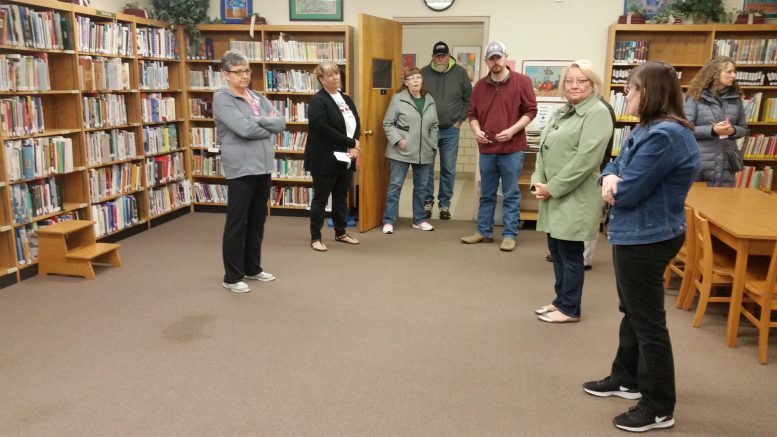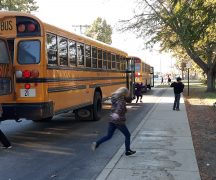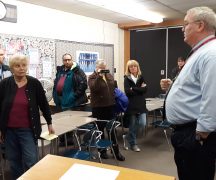By JAN LARSON McLAUGHLIN
BG Independent News
For more than 60 years, Conneaut and Kenwood elementaries have educated young minds. They continue to do so – but under some challenging conditions.
The heat at both elementaries leaves some students sweltering while others have to be bundled in their coats. The gym floor at Kenwood is buckled, and the microwave in the kitchen has to be moved around to open outlets.
Lack of storage space in both schools has led to some items sitting in the halls. Asbestos contained in the ceilings means nothing – not even a staple – can but put in the tiles. Conneaut’s art teacher’s classroom is sometimes a cart, since some years there is no extra room for her class.
Residents of the school district were invited into the two elementaries and the high school for tours on Saturday. The district is trying to pass a 5.7-mill levy to construct a centralized elementary, plus renovate and add onto the high school.
The tours were in response to criticism by levy opponents, who would rather see the elementaries renovated, costing the district $30 million less than the $72 million price tag for the high school and new consolidated elementary.
It seemed few minds were swayed by the school tours.
Those against the levy questioned why the district would build a new building, when the 60-plus-year-old elementaries can be renovated. Those for the levy asked why the district would put a band-aid on big problems and delay constructing new buildings as the costs continue to grow.
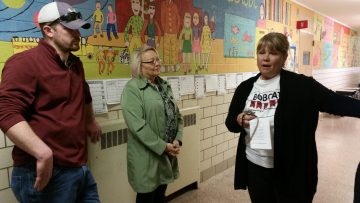
Kenwood Principal Kathleen Daney gives tour of school.
Both sides seemed to dig in during Saturday’s tours.
Some parents on the tours expressed disappointment in efforts to “attack the integrity” of the school board and administration.
“That’s what’s driving me nuts about this,” one father said.
Getting lost in the verbal battles are the children, Superintendent Francis Scruci said at the end of the Kenwood tour. “It’s the best thing for kids,” he said of the building plan.
That message was drowned out by David Apple, who is opposed to the levy. The district will be saddled with the bond issue for 37 years, but Scruci won’t last 10 years here before he is “run out of town,” Apple said.
Following are some of the items pointed out by building principals during Saturday’s tours.
At Kenwood, Principal Kathleen Daney explained that she came to Bowling Green City Schools about five years ago from Toledo Public Schools. She talked about the building’s asbestos contained in the ceilings, the dim lighting, leaks in the rooms from the steam heat, and a closet being used for the school counselor. The teachers’ lounge is crammed into a room that is also used for storage.
“I was kind of shocked that this is the best we can do,” Daney said, recalling her first reaction to the building.
The school’s many entrances make security difficult, she said.
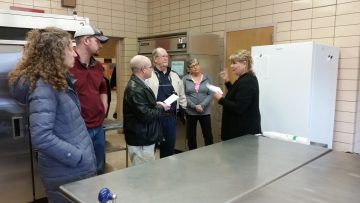
Kenwood Principal Kathleen Daney answers questions in school kitchen.
The kitchen is cramped, with insufficient electric, and the gym floor is no longer flat. Jeremy Koehler, the physical education teacher, said students trip over the uneven flooring.
The heating pipes running beneath the building create uneven temperatures throughout the school.
“There are days it’s like a sauna,” Daney said as she entered one room near the center of the school.
But down at the far end of the hall, the kindergartners sometimes have to leave their coats on for the first half of the day. “It takes a long time for the heat to get to this area,” she said.
Grant Chamberlain, an opponent of the school levy, asked if the district has brought in commercial heating people to look at the school’s system. Daney said yes, and added “We try to be fiscally responsible, I guarantee you that.”
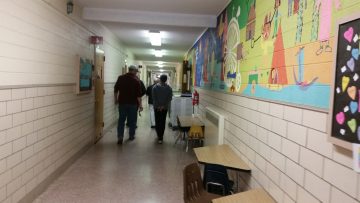
Kenwood hallway
Daney pointed out some issues caused by lack of space – such as the chrome book carts that are stored in the hallway since there is no space in the classrooms.
“The fire marshal is always on us,” she said.
The PACE teacher for gifted students has to store her supplies in the district bus garage on Bishop Road, Daney said.
But some of her examples fell on unsympathetic ears. Daney showed the office shared by the physical education teacher and the school nurse.
“Same as when I was here in ’91,” Chamberlain said.
The principal pointed out that teachers are now expected to handle a range of levels in their classrooms, with children who have a variety of disabilities. Apple said that isn’t much different than the past when several grades were educated together. “They were in the same room,” he said.
School librarian Tami Lynch, who has been with the district since 1981, said additions have been put on the elementaries, roof repairs have been made and heating contractors have tried to solve problems.
“It’s just time,” for a new building, Lynch said.
But Apple sees it differently.
“The maintenance has been neglected,” Apple said. “If you had a bathroom leaking in your house, would you build a new house?”
Chamberlain agreed.
“They need to fire their heating and cooling contractor and get one that’s worth a shit,” he said.
However, others on the tour see renovating the 60-plus year old buildings as kicking the can down the road. They want the levy passed so the district isn’t facing the same problems in a few years.
“I want to do it for my students,” Koehler said.
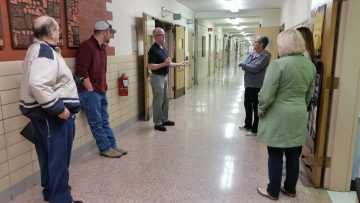
Conneaut Principal Jim Lang talks about elementary building.
Similar building issues were identified during the Conneaut tour, led by Principal Jim Lang. In the library, electrical cords run across the floor with rugs over them so students don’t trip. The school nurse and counselor share a small room, so they lack confidentiality.
Some rooms have carpet on the walls to cut down on noise – but it can’t thoroughly be cleaned, Lang said. Some holes in carpeted classroom floors are patched with duct tape.
Lang, who also came from Toledo schools, has been at Conneaut for about six years.
“When I came here, music was on a cart half a day,” and the other half in the cafeteria, he said. The art teacher has also taught off a cart, due to lack of space.
Retired teacher Barb Belleville said that isn’t unusual.
“That is very typical of specials,” she said.
Maybe so, Lang said, but that doesn’t make it right.
“It’s certainly not what’s best for students,” he said.
“I come from a generation where I want better for my kids,” Lang continued.
Chamberlain said he wants better for his kids too, but said he is going to have to tell his son that their farm won’t survive this tax levy for the schools.
Lang questioned if Chamberlain’s parents supported the schools when he was younger. He replied that they supported the FFA.
As the tour went on, Lang also pointed out asbestos contained in the ceiling and under the stage in the gym. “We can’t do anything with the ceiling. We can’t put a staple in the ceiling.”
The heat is also a problem, with some classrooms roasting at 90 degrees and others chilling at 60 degrees during the winter. Lang said he doesn’t care about air conditioning, and has heard plenty people complain, “I went to school without air conditioning.”
However, he would like consistent heat.
Security is also more of an issue at Conneaut, since its main entrance is not configured with a locked area where visitors have to be buzzed into the building.
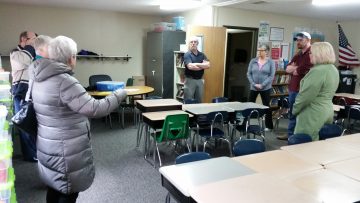
Citizens ask questions while in modular unit at Conneaut.
Space is probably the biggest problem. Currently, one room is shared for the sensory room, occupational and physical therapy, adaptive therapy and English as a second language programs. That room is needed as a classroom next year, so those special programs will be put wherever space can be found. School districts are now required to provide services for children with those special needs, Lang explained.
Currently, the fourth grades use modular classrooms located behind the school. Next year, those modulars will be used for the preschool program that is now housed at Crim.
A consolidated elementary would mean consistent class sizes – which can’t be done now unless children are bounced from one school to another as class sizes fluctuate each year.
“I don’t think that’s what’s best for kids,” Lang said of moving students.
But as it is now, classroom numbers vary greatly from one school to another. Conneaut’s kindergarten classes average 25, compared to Crim’s at 21, and Kenwood’s at 17 or 18.
“When you have that discrepancy, it’s not fair to the teachers and it’s not fair to the students,” former educator Linda Lander said.
The consolidated elementary would be built to allow for growth, with room for 12 classrooms per grade level, compared to 10 now.
The tour of the high school, led by Principal Jeff Dever, also pointed out deficiencies.
“Don’t have a flat roof,” Dever said, pointing to the brown-stained ceiling in the high school hallway. “These tiles were in good shape in February. Every time we get a big rain, we roll the trash cans out and it drips in about three areas.”
Like the other older schools, the high school gets “unbelievably hot.” Temperatures at 100 degrees and higher make it hard for students to learn, and hard for teachers to educate, he said.
The second floor averages temperatures 15 degrees higher than the main floor, and some teachers have to open windows in the winter.
One classroom on the second floor lacks structural stability. “You can jump on the floor, and you can feel the reverberations,” he said as he jumped and the floor shook.
The weight room is located on the second floor over the cafeteria annex. “When a kid drops a dumbbell, you can hear it hit the floor,” Dever said.
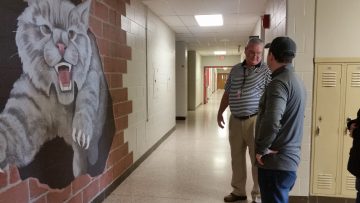
High School Principal Jeff Dever leads tour of school.
The district recently spent $380,000 to renovate the high school locker room after one of the showers “started to implode.”
“It was absolutely terrible,” under the floor, with the metal joists deteriorating.
The average classroom size is too small, and with 17 entrances, the school is difficult to secure from intruders who want to cause harm, Dever said.
“If anybody wanted to do us harm, they’d have an easy time doing it,” he said.
The northern portion of the high school would be renovated, while the southern portion would be removed and replaced by a larger addition.
“Is there education happening here? Yes,” Dever said. “It’s a good school, but in 10 years, the problems are going to be exacerbated.”
Dever objected to claims that the district hasn’t done a good job maintaining its structures.
“We do a really good job maintaining the building,” he said. “I think the time has come. But I have one vote, just like everybody else.”

